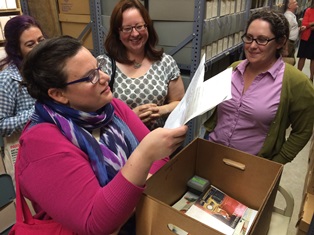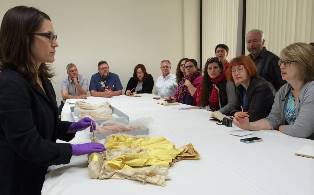Pass Attends National Endowment for the Humanities Modern Design Seminar
 |
| Dr. Victoria Pass explores a box of historical ephemera at the Hagley Museum. |
Pass was one of 25 educators selected to attend the National Endowment for the Humanities’ four-week seminar “Teaching the History of Modern Design: The Canon and Beyond” at Drexel University.
During the seminar, six international scholars, including director Dr. David Raizman, author of History of Modern Design, discussed topics including the influence of taste, gender and globalization in design — topics Pass said are not always covered cohesively in textbooks.
“It was wonderful to be with this great group of people and learn how they were addressing these issues in their own classrooms,” she said. “We are all a part of a relatively young field of study, and we all have a part in defining what the field of design history will look like in both our scholarship and our teaching. We are working toward developing a field which is interdisciplinary and inclusive, and engages with questions that have continued relevance to contemporary designers.”
Trips to museums in Philadelphia and surrounding areas, such as the Hagley Museum in Wilmington, DE, home of the corporate archives of Avon Products, Inc. and other businesses, allowed the educators to study historical source material up close. They also had the chance to explore objects in Drexel University’s Robert and Penny Fox Historic Costume Collection, at the Philadelphia Museum of Art, and at the Fashion Institute of Technology in New York.
 |
| Participants attend a presentation at the Fashion Institute of Technology. |
“I really enjoyed being a student again. You really see what works and what doesn’t,” she said, citing the small group discussions that allowed participants to make their own observations and build on others while looking at the historical items.
Following the seminar, she said she would like to incorporate more primary source material into her classes, and teach students how to use the Internet and local libraries to find it. She hopes the ability to see these items close-up will spark similar excitement and observations among SU’s design students.
“The institute showed me the value of having students engage with historical content in a significant way, rather than only digesting it through more traditional lectures and readings,” she said. “I want students to fall down the research rabbit hole the way that I do and spark the excitement of discovery that happens when they find these things on their own. I hope that what they discover will have an impact on their own practice as designers.”
This fall, Pass will teach the history of graphic design. In the spring, her students will learn about the history of fashion. In November, She leads the Adventures in Humanities: Seminar Series presentation “The Look of Victory: Design and Visual Culture in the ‘Long’ Fifties,” sponsored by the Charles R. and Martha N. Fulton School of Liberal Arts and Whaley Family Foundation.
For more information call 410-543-6030 or visit the SU website at www.salisbury.edu.
